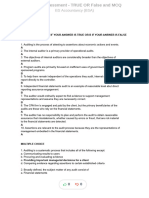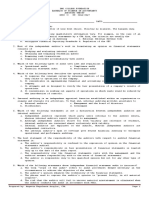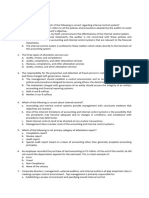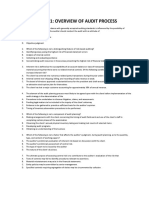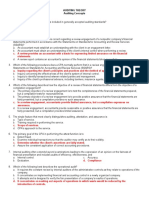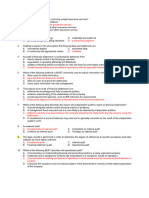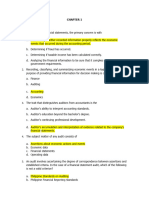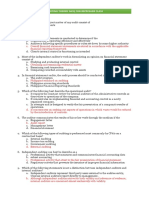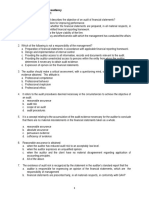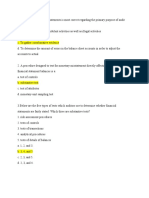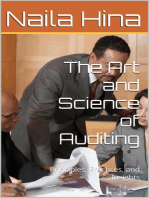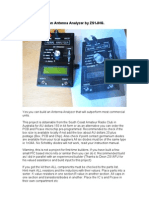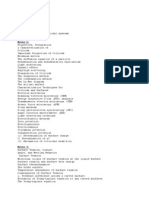0 ratings0% found this document useful (0 votes)
7 viewsKTCB
KTCB
Uploaded by
ngothimyduyen27042003The document discusses types of audits including financial statement audits, operational audits, compliance audits, and internal audits. It also discusses audit objectives, risks, and internal controls. Key topics covered include inherent risk, detection risk, control risk, audit procedures, the purpose of considering internal controls, and engagement letters.
Copyright:
© All Rights Reserved
Available Formats
Download as DOCX, PDF, TXT or read online from Scribd
KTCB
KTCB
Uploaded by
ngothimyduyen270420030 ratings0% found this document useful (0 votes)
7 views13 pagesThe document discusses types of audits including financial statement audits, operational audits, compliance audits, and internal audits. It also discusses audit objectives, risks, and internal controls. Key topics covered include inherent risk, detection risk, control risk, audit procedures, the purpose of considering internal controls, and engagement letters.
Copyright
© © All Rights Reserved
Available Formats
DOCX, PDF, TXT or read online from Scribd
Share this document
Did you find this document useful?
Is this content inappropriate?
The document discusses types of audits including financial statement audits, operational audits, compliance audits, and internal audits. It also discusses audit objectives, risks, and internal controls. Key topics covered include inherent risk, detection risk, control risk, audit procedures, the purpose of considering internal controls, and engagement letters.
Copyright:
© All Rights Reserved
Available Formats
Download as DOCX, PDF, TXT or read online from Scribd
Download as docx, pdf, or txt
0 ratings0% found this document useful (0 votes)
7 views13 pagesKTCB
KTCB
Uploaded by
ngothimyduyen27042003The document discusses types of audits including financial statement audits, operational audits, compliance audits, and internal audits. It also discusses audit objectives, risks, and internal controls. Key topics covered include inherent risk, detection risk, control risk, audit procedures, the purpose of considering internal controls, and engagement letters.
Copyright:
© All Rights Reserved
Available Formats
Download as DOCX, PDF, TXT or read online from Scribd
Download as docx, pdf, or txt
You are on page 1of 13
CHƯƠNG 1
1.Governmental auditing, in addition to including audits of financial statements,
often
includes audits of efficiency, effectiveness, and:
a. Adequacy.
b. Evaluation.
c. Accuracy.
d. Compliance
CHƯƠNG 1
1.Governmental auditing, in addition to including audits of financial
statements, often includes audits of efficiency, effectiveness, and:
a. Adequacy.
b. Evaluation.
c. Accuracy.
d. Compliance
2.In general, internal auditors’ independence will be greatest when they report
directly to the:
a. financial vice president.
b. corporate controller.
c. Audit committee of the board of directors.
d. Chief executive officer.
3.Which of the following organizations establishes auditing standards for
Vietnam government agencies?
a. Ministry of Financial
b. Vietnam Association of Certified Public Accountants
c. Vietnam Association of Accountants and Auditors
d. State Audit of Vietnam
4.Which of the following is an example of a compliance audit?
a. An audit of financial statemen
b. An audit of a company’s policies and procedures for adhering to environmental
laws and regulations.
c. An audit of a company’s internal control over financial reporting.
d. An audit of the efficiency and effectiveness of a company’s legal department
5.Which of the following is an example of an operational audit?
a. An audit of financial statements.
b. An audit of a company’s policies and procedures for adhering to environmental
laws and regulations.
c. An audit of a company’s internal control over financial reporting.
d. An audit of the efficiency and effectiveness of a company’s legal department.
6.Which of the following is an example of an audit of financial statements
audit?
a. An audit of the efficiency and effectiveness of a company’s legal department
b. An audit of a company’s policies and procedures for adhering to environmental
laws and regulations.
c. An audit of the true and fair of a company’s financial statements
d. An audit of the efficiency and effectiveness of a company’s financial statements
8.Independent audit increases the reliability of information on the financial
statements to help those interested in the following:
a. The corporate governances
b. The government agencies
c. The investors
d. a, b, and c are right.
9.What do Types of audits include?
a. Operational audit, financial statements audit, independent audit
b. Operational audit, financial statements audit, compliance audit
c. financial statements audit, internal audit, independent audit
d. Compliance audit, internal audit, government audit.
10.What do Types of auditors include?
a. Operational audit, internal audit, independent audit
b. Operational audit, financial statements audit, compliance audit
c. Government, internal audit, independent audit
d. Compliance audit, internal audit, government audit
CHƯƠNG 2
1. Which of the following is not a financial statement assertion made by
management?
A. Existence of recorded assets and liabilities
B. Completeness of recorded assets and liabilities
C. Valuation of assets and liabilities
D. Effectiveness of internal control
2.Which of the following business characteristics is not indicative of high
inherent risk?
a. Operating results that are highly sensitive to economic factors.
b. Large likely misstatements detected in prior audits.
c. Substantial turnover of management.
d. A large amount of assets.
3. The risk that the auditors will conclude, based on substantive procedures,
that a material misstatement does not exist in an account balance when, in fact,
such misstatement does exist is referred to as
a. Inherent risk.
b. Audit risk.
c. Control risk.
d. Detection risk
4. Three conditions generally are present when fraud occurs. Select the one
below that is not one of those conditions.
a. Incentive or pressure.
b. Opportunity.
c. Supervisory position.
d. Attitude.
5.“Auditors use less predictable audit procedures”. Such misstatement does
exist is referred to as
a. Engagement risk.
b. Business risk.
c. Control risk.
d. Detection risk
6.Which of the following risks are not related to the functioning, operating
characteristics
of the audited firm?
a. Inherent risk, Audit risk
b. Business risk, Control risk
c. Detection risk, Audit risk
d. a, b and c are right.
7.Which of the following risks are not related to the audit procedure of auditors?
a. Inherent risk, Audit risk
b. Inherent risk, Control risk
c. Detection risk, Audit risk
d. a, b and c are right.
8.Which of audit objectives related to the inventory of fixed assets at the end of
fiscal
period?
a. Existence
b. Accuracy
c. Completeness
d. Rights
9.Which of audit objectives related the auditors might select a sample of shipping
documents issued during the year and trace the details to recorded sale transactions?
a. Existence
b. Accuracy
c. Completeness
d. Rights
10.Which of the following content is an audit objective?
a. Existence
b. Efficiency
c. Effectiveness
d. a, b and c are right.
6.Which of the following risks are not related to the functioning, operating
characteristics of the audited firm?
a. Inherent risk, Audit risk
b. Business risk, Control risk
c. Detection risk, Audit risk
d. a, b and c are right.
7.Which of the following risks are not related to the audit procedure of
auditors?
a. Inherent risk, Audit risk
b. Inherent risk, Control risk
c. Detection risk, Audit risk
d. a, b and c are right.
8.Which of audit objectives related to the inventory of fixed assets at the end of
fiscal period?
a. Existence
b. Accuracy
c. Completeness
d. Rights
9.Which of audit objectives related the auditors might select a sample of
shipping documents issued during the year and trace the details to recorded
sale transactions?
a. Existence
b. Accuracy
c. Completeness
d. Rights
10.Which of the following content is an audit objective?
a. Existence
b. Efficiency
c. Effectiveness
d. a, b and c are right.
CHƯƠNG 3
1. What best describes the purpose of the independent auditors’ consideration
of internal control in a financial statement audit for a public company.
a. To determine the nature, timing, and extent of audit testing.
b. To make recommendations to the client regarding improvements in internal
control.
c. To train new auditors on accounting and control systems.
d. To identify opportunities for fraud within the client’s operations.
2.An auditor may compensate for a weakness in internal control by increasing
the extent of:
a. Tests of controls
b. Detection risk
c. Substantive tests of details
d. Inherent risk
3.Which of the following would be least likely to be considered an objective of
internal control?
a. Checking the accuracy and reliability of accounting data.
b. Detecting management fraud.
c. Encouraging adherence to managerial policies.
d. Safeguarding assets.
4.An entity’s monitoring activities often include:
a. Periodic audits by internal auditors.
b. The audit of the annual financial statements.
c. Management review of weekly performance reports.
d. a, b and c are right.
5.A primary objective of procedures performed to obtain an understanding of
internal control is to provide the auditors with:
a. Audit evidence to use in reducing detection risk.
b. An evaluation of the control risk
c. A basis for modifying tests of controls.
d. An evaluation of the consistency of application of management policies
6.Controls over financial reporting are often classified as preventative,
detective, or corrective. Which of the following is an example of detective m m
control?
a. Segregation of duties over cash disbursements.
b. Requiring approval of purchase transactions.
c. Preparing bank reconciliations.
d. Maintaining backup copies of key transactions.
7.Controls over financial reporting are often classified as preventative,
detective, or corrective. Which of the following is an example of a preventative
control?
a. Segregation of duties over cash disbursements.
b. Requiring approval of purchase transactions.
c. Maintaining backup copies of key transactions.
d. a, b and c are right.
8.Of the following statements about internal control, which one is not valid?
a. No one person should be responsible for the custody and the recording of an
asset.
b. Transactions should be properly authorized before such transactions are
processed.
c. Because of the cost/benefit relationship, a client may apply controls on a test
basis.
d. Controls reasonably ensure that collusion among employees cannot occur.
9.When a CPA decides that the work performed by internal auditors may have
an effect on the nature, timing, and extent of the CPA’s procedures, the CPA
should consider the competence and objectivity of the internal auditors.
Relative to objectivity, the CPA should:
a. Consider the organizational level to which the internal auditors report the results
of their work.
b. Review the internal auditors ‘work.
c. Consider the qualifications of the internal audit staff.
d. Review the training program in effect for the internal audit staffs.
CHƯƠNG 4
1.Which of the following should not normally be included in the engagement
letter for an audit?
a. A description of the responsibilities of client personnel to provide assistance.
b. An indication of the amount of the audit fee.
c. A description of the limitations of an audit.
d. A listing of the client’s branch offices selected for testing.
2.Which portion of an audit is least likely to be completed before the balance
sheet date?
a. Tests of controls.
b. Issuance of an engagement letter.
c. Substantive procedures.
d. Assessment of control risk.
3.Which of the following should the auditors obtain from the predecessor
auditors before accepting an audit engagement?
a. Analysis of balance sheet accounts.
b. Analysis of income statement accounts.
c. All matters of continuing accounting significance.
d. Facts that might bear on the integrity of management.
4.The primary objective of tests of details of transactions performed as
substantive procedures is to:
a. Comply with generally accepted auditing standards.
b. Attain assurance about the reliability of the accounting system.
c. Detect material misstatements in the financial statements.
d. Evaluate whether management’s policies and procedures are operating
effectively.
5. Which of the following is not a procedure to obtain an understanding of risk
in the planning stage (described in VSA/ISA 315)?
A. Inquiries of management
B. Observation and inspection
C. Analytical procedures
D. Procedures for sampling audit tests.
CHƯƠNG 5
1. As part of their audit, auditors obtain a representation letter from their client.
Which of
the following is not a valid purpose of such a letter?
a. To increase the efficiency of the audit by eliminating the need for other audit
procedures.
b. To remind the client’s management of its primary responsibility for financial
statements.
c. To document in the audit working papers the client’s responses to certain verbal
inquiries made by the auditors during the engagement.
d. To provide evidence in those areas dependent upon management’s future
intentions.
2.Which of the following statements best describes why auditors investigate related
party
transactions?
a. Related party transactions generally are illegal acts.
b. The substance of related party transactions may differ from their form.
c. All related party transactions must be eliminated as a step in preparing
consolidated
financial statements.
d. Related party transactions are a form of management fraud.
3.Of the following, which is the least reliable type of audit evidence?
a. Confirmations mailed by outsiders to the auditors.
b. Correspondence between the auditors and suppliers.
c. Copies of sales invoices inspected by the auditors.
d. Canceled checks returned in the year-end bank statement directly to the client.
4. Analytical procedures are most likely to detect:
a. Weaknesses of a material nature in internal control.
b. Unusual transactions.
c. Noncompliance with prescribed control
d. Improper separation of accounting and other financial duties
5.In using the work of a specialist, the auditors referred to the specialist’s findings
in their
report. This would be an appropriate reporting practice if the:
a. Client is not familiar with the professional certification, personal reputation, or
particular competence of the specialist.
b. Auditors, as a result of the specialist’s findings, give a qualified opinion on the
financial statements.
c. Client understands the auditors’ corroborative use of the specialist’s findings in
relation
to the representations in the financial statements.
d. Auditors, as a result of the specialist’s findings, decide to indicate a division of
responsibility with the specialist.
CHƯƠNG 6
1.An auditor accepted an engagement to audit. The 20X8 financial statements of
EFG
Corporation and began the fieldwork on September 30, 20X8. EFG gave the
auditor the
20X8 financial statements on January 17, 20X9. The auditor completed the audit on
February 10, 20X9, and issued the report on February 16, 20X9. The client’s
representation letter normally would be dated:
a) December 31, 20X8.
b) January 17, 20X9.
c) February 10, 20X9.
d) February 16, 20X9.
2.Which of the following is most likely to be considered a subsequent event
required
adjustment to the financial statements?
a) A business combination completed after year-end, but for which negotiations
began
prior to year-end.
b) A strike subsequent to year-end due to employee complaints about working
conditions
which originated two years ago.
c) Customer checks deposited prior to year-end but determined to be uncollectible
after
year-end.
d) Introduction of a new line of products after year-end for which major research
had
been completed prior to year-end.
3.Which of the following events occurring on January 5, 20X2, is most likely to
result
require disclosure in the notes to the 20X1 financial statements (if material)?
) A business combination.
b) Early retirement of bonds payable.
c) Plant closure due to a strike.
d) All are correct.
4.Which of the following is least likely to be considered as an “emphasis of matter”
in
what remains an unqualified audit report?
a) The company is a component of a larger business enterprise.
b) An unusually important significant event.
c) A decision not to confirm accounts receivable.
d) A risk or uncertainty.
5.The auditor who wishes to indicate that the entity has significant transactions with
related parties should disclose this fact in:
a) An explanatory paragraph to the auditors’ report
b) An explanatory note to the financial statements.
c) The body of the financial statements.
d) The “summary of significant accounting policies” section of the financial
statements.
6.When restrictions that significantly limit the scope of the audit are imposed by the
client. But it does no effect pervasive on the financial statements. The auditor
should
generally issue which of the following opinions?
a) Qualified.
b) Disclaimer.
c) Adverse.
d) Unqualified
7.When restrictions that significantly limit the scope of the audit are imposed by the
client. And it effects pervasive on the financial statements. The auditor should
generally
issue which of the following opinions?
a) Qualified.
b) Disclaimer.
c) Adverse.
d) Unqualified
8.When financial statements are materially misstated, the auditor should generally
issue
which of the following opinions?
a) Qualified.
b) Disclaimer.
c) Adverse.
d) a or c
9.When the auditor disagreement with management regarding the acceptability of
the
accounting policies selected and it effects pervasive on the financial statements. The
auditor should generally issue which of the following opinions?
a) Qualified.
b) Disclaimer.
c) Adverse.
d) Unqualified
10.When the auditor disagreement with management regarding the acceptability of
the
accounting policies selected and it does not affect pervasive on the financial
statements.
The auditor should generally issue which of the following opinions?
a) Qualified.
b) Disclaimer.
c) Adverse.
d) Unqualified
You might also like
- Auditing Theory MCQs by Salosagcol With AnswersDocument31 pagesAuditing Theory MCQs by Salosagcol With AnswersYeovil Pansacala79% (62)
- Engineering Report: Air Pollution Sources Equipment (APSE) For Fuel Burning Subject For PermittingDocument3 pagesEngineering Report: Air Pollution Sources Equipment (APSE) For Fuel Burning Subject For PermittingMark Louie Guinto100% (2)
- Audit Assessment True or False and MCQ - CompressDocument8 pagesAudit Assessment True or False and MCQ - CompressHazel BawasantaNo ratings yet
- Long Test Aud Theo 1-15Document42 pagesLong Test Aud Theo 1-15kawaiimiracleNo ratings yet
- Long Test Aud Theo 1-6Document25 pagesLong Test Aud Theo 1-6kawaiimiracleNo ratings yet
- AT Quiz 1Document2 pagesAT Quiz 1CattleyaNo ratings yet
- Assignment 1 in Auditing TheoryDocument6 pagesAssignment 1 in Auditing TheoryfgfsgsrgrgNo ratings yet
- AUDITTHEODocument13 pagesAUDITTHEOAlisonNo ratings yet
- CPAR 1stPBDocument12 pagesCPAR 1stPBMae Danica CalunsagNo ratings yet
- Acctg 14 Final ExamDocument8 pagesAcctg 14 Final ExamErine100% (1)
- Prelim With Answer Keys PDFDocument7 pagesPrelim With Answer Keys PDFheyheyNo ratings yet
- Auditing Theory - Quiz 1Document5 pagesAuditing Theory - Quiz 1MA ValdezNo ratings yet
- QuestionsDocument2 pagesQuestionsKristel Keith NievaNo ratings yet
- FINAL EXAM - ACTG411 Assurance Principles, Professional Ethics & Good GovDocument20 pagesFINAL EXAM - ACTG411 Assurance Principles, Professional Ethics & Good GovMarilou PanisalesNo ratings yet
- Audit Mcqs - CparDocument31 pagesAudit Mcqs - Cparjpbluejn50% (2)
- At.02 Introduction To Audit of Historical Financial InformationDocument4 pagesAt.02 Introduction To Audit of Historical Financial InformationAngelica Sanchez de VeraNo ratings yet
- Test BankDocument9 pagesTest BankKristel Keith NievaNo ratings yet
- Material No. 1Document6 pagesMaterial No. 1Jen AnchetaNo ratings yet
- It AuditDocument10 pagesIt AuditVandixNo ratings yet
- Internal Control DIYDocument20 pagesInternal Control DIYだみNo ratings yet
- Chapter 1 QuestionsDocument7 pagesChapter 1 QuestionsAyame MalinaoNo ratings yet
- Midterm Exam EnjoyDocument14 pagesMidterm Exam EnjoygarciarhodjeannemarthaNo ratings yet
- Auditing Theory SalosagcolDocument4 pagesAuditing Theory SalosagcolYuki CrossNo ratings yet
- Preboard 1Document9 pagesPreboard 1Janica Berba100% (1)
- Audit Theo FPB With Answer KeysDocument6 pagesAudit Theo FPB With Answer KeysPj Manez100% (1)
- AP 01 Overview of Audit Process AdUDocument5 pagesAP 01 Overview of Audit Process AdUziNo ratings yet
- Audit PlanningDocument12 pagesAudit Planninginto the unknownNo ratings yet
- Midterm Act 2Document4 pagesMidterm Act 2MikNo ratings yet
- C. An Unreliable Accounting SystemDocument2 pagesC. An Unreliable Accounting SystemGlaizzaNo ratings yet
- Auditing Theory Auditing ConceptsDocument15 pagesAuditing Theory Auditing ConceptsEllah MaeNo ratings yet
- Aud FeDocument11 pagesAud FeMark Domingo MendozaNo ratings yet
- Auditing Theory Mcqs by Salosagcol With AnswersDocument31 pagesAuditing Theory Mcqs by Salosagcol With AnswersLeonard Cañamo100% (1)
- Audit 1Document1 pageAudit 1zennongraeNo ratings yet
- AT PrelimDocument32 pagesAT Prelimfer maNo ratings yet
- Aud Module 1-5Document23 pagesAud Module 1-5yaanvinaNo ratings yet
- Auditing Theory - 1Document9 pagesAuditing Theory - 1Kageyama HinataNo ratings yet
- First PreboardDocument5 pagesFirst PreboardRodmae VersonNo ratings yet
- At MCQ PDFDocument24 pagesAt MCQ PDFNyra BeldoroNo ratings yet
- Introduction To Internal Auditing: Practice Questions and AnswersDocument3 pagesIntroduction To Internal Auditing: Practice Questions and AnswersPeter CR7No ratings yet
- Auditing Theory ComprehensiveDocument14 pagesAuditing Theory ComprehensiveMary GarciaNo ratings yet
- Audit 1stDocument10 pagesAudit 1stFrie NdshipMaeNo ratings yet
- Questions and AnswersDocument20 pagesQuestions and AnswersJi YuNo ratings yet
- Consideration of Internal ControlDocument4 pagesConsideration of Internal ControlMary Grace SalcedoNo ratings yet
- Auditing TheoryDocument15 pagesAuditing Theorydexterespinoza123No ratings yet
- Attribute Standards QuizDocument16 pagesAttribute Standards QuizJao FloresNo ratings yet
- Audit Planning MCQDocument10 pagesAudit Planning MCQexquisiteNo ratings yet
- Practice Questions - Module 5Document8 pagesPractice Questions - Module 5Rosda DhangNo ratings yet
- 111年會考 審計學題庫Document15 pages111年會考 審計學題庫張巧薇No ratings yet
- AT7Document8 pagesAT7gazer beamNo ratings yet
- 1st AudPB-89th-FEB 2021Document13 pages1st AudPB-89th-FEB 2021Ziee00No ratings yet
- Aut QDocument3 pagesAut QdreianyanmaraNo ratings yet
- True / False QuestionsDocument19 pagesTrue / False QuestionsRizza OmalinNo ratings yet
- Chapter 1Document27 pagesChapter 1julita08No ratings yet
- Midterm Exam AUD001Document7 pagesMidterm Exam AUD001KathleenNo ratings yet
- Reviewer in AuditngDocument32 pagesReviewer in AuditngHazel MoradaNo ratings yet
- RPT and Local Business TaxesDocument14 pagesRPT and Local Business TaxesoxennnnNo ratings yet
- Audit Risk Alert: Government Auditing Standards and Single Audit Developments: Strengthening Audit Integrity 2018/19From EverandAudit Risk Alert: Government Auditing Standards and Single Audit Developments: Strengthening Audit Integrity 2018/19No ratings yet
- Audit Risk Alert: General Accounting and Auditing Developments 2018/19From EverandAudit Risk Alert: General Accounting and Auditing Developments 2018/19No ratings yet
- The Art and Science of Auditing: Principles, Practices, and InsightsFrom EverandThe Art and Science of Auditing: Principles, Practices, and InsightsNo ratings yet
- Annual Update and Practice Issues for Preparation, Compilation, and Review EngagementsFrom EverandAnnual Update and Practice Issues for Preparation, Compilation, and Review EngagementsNo ratings yet
- C LanguageDocument26 pagesC LanguageMark 42No ratings yet
- 17S2 EE3010 PPT Lecture7-TransformersDocument25 pages17S2 EE3010 PPT Lecture7-Transformersming yangNo ratings yet
- Digital Input Module SM 321 DI 32 X DC 24 V (6ES7321-1BL00-0AA0)Document3 pagesDigital Input Module SM 321 DI 32 X DC 24 V (6ES7321-1BL00-0AA0)Fabio CavalheiroNo ratings yet
- INST232 Sec1Document99 pagesINST232 Sec1Herman DamanikNo ratings yet
- MetabolismDocument21 pagesMetabolismNagendra NayakNo ratings yet
- Raidy 2 ManualDocument2 pagesRaidy 2 ManualsdghyNo ratings yet
- Development of Smart Multi-Level Inverter With Remote Monitoring SystemDocument5 pagesDevelopment of Smart Multi-Level Inverter With Remote Monitoring SystemRavindra ParabNo ratings yet
- Utility CapabilitiesDocument6 pagesUtility CapabilitiesyesrtyNo ratings yet
- Technical Guidance Document For Terms of Reference (TOR) : EAD-EQ-PCE-TG-04Document15 pagesTechnical Guidance Document For Terms of Reference (TOR) : EAD-EQ-PCE-TG-04Nisa KgNo ratings yet
- Basic Excel LearningDocument62 pagesBasic Excel LearningNikhil Kumar TiwaryNo ratings yet
- ME505 Assignment 2 T3 2022Document4 pagesME505 Assignment 2 T3 2022Kavindu PereraNo ratings yet
- Timing Issues in Digital Circuits: Edge-Triggered D Flip FlopDocument4 pagesTiming Issues in Digital Circuits: Edge-Triggered D Flip FlopBinh NguyenNo ratings yet
- The Crash of Morgan Stanley Executive Zoe Cruz - New York MagazineDocument12 pagesThe Crash of Morgan Stanley Executive Zoe Cruz - New York MagazinelarpNo ratings yet
- Sampling and Its TypesDocument8 pagesSampling and Its TypesSadaf RasheedNo ratings yet
- SL3 Series Energy Efficiency Report - V1.00Document3 pagesSL3 Series Energy Efficiency Report - V1.00fslkamaliNo ratings yet
- TG Catchup Peace Ed Grade 12 March 8Document5 pagesTG Catchup Peace Ed Grade 12 March 8iamtherealjuandelacruzNo ratings yet
- LanternDocument5 pagesLanternangellingon.25No ratings yet
- CadburyDocument33 pagesCadburyVarun JainNo ratings yet
- spark_notesDocument19 pagesspark_notesAli SaberiNo ratings yet
- Building Your Own Antenna Analyzer by ZS1JHGDocument9 pagesBuilding Your Own Antenna Analyzer by ZS1JHGJohn Howard Green100% (8)
- Taws Class A & B - Tsoc151bpaperDocument49 pagesTaws Class A & B - Tsoc151bpaperMuhammadFikriSNo ratings yet
- Dmart Finlatics PDF FreeDocument11 pagesDmart Finlatics PDF Freeashutosh shendgeNo ratings yet
- Cn5131 OutlineDocument6 pagesCn5131 OutlineAki EspaldonNo ratings yet
- CHAPTER 1: An Overview of Organizational BehaviorDocument29 pagesCHAPTER 1: An Overview of Organizational BehaviorJessie jorgeNo ratings yet
- KCET HandBookDocument22 pagesKCET HandBookTHARUN KunthurNo ratings yet
- ScoliosisDocument62 pagesScoliosisAbhinav Gupta50% (2)
- Baluchistan Black Bear: Scientific ClassificationDocument3 pagesBaluchistan Black Bear: Scientific ClassificationRoshan PMNo ratings yet
- The History of Browning Firearms by David MillerDocument20 pagesThe History of Browning Firearms by David Millerv1335432100% (3)
- Collected ProseDocument458 pagesCollected Proseamsj100% (2)


